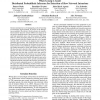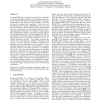5665 search results - page 1125 / 1133 » Introduction to Computer Security |
AAAI
2006
13 years 10 months ago
2006
Intrusion attempts due to self-propagating code are becoming an increasingly urgent problem, in part due to the homogeneous makeup of the internet. Recent advances in anomalybased...
ACSW
2006
13 years 10 months ago
2006
Current IEEE 802.11 wireless networks are vulnerable to session hijacking attacks as the existing standards fail to address the lack of authentication of management frames and net...
CASCON
2006
13 years 10 months ago
2006
One aspect of autonomic computing is the ability to identify, separate and automatically tune parameters related to performance, security, robustness and other properties of a sof...
CSREASAM
2006
13 years 10 months ago
2006
The widely acknowledged problem of reliably identifying the origin of information in cyberspace has been the subject of much research. Due to the nature of the Internet protocol, ...
ISSA
2004
13 years 10 months ago
2004
Nearly all present-day commercial intrusion detection systems are based on a hierarchical architecture. Nodes at the bottom of the hierarchy collect information, which is passed t...


